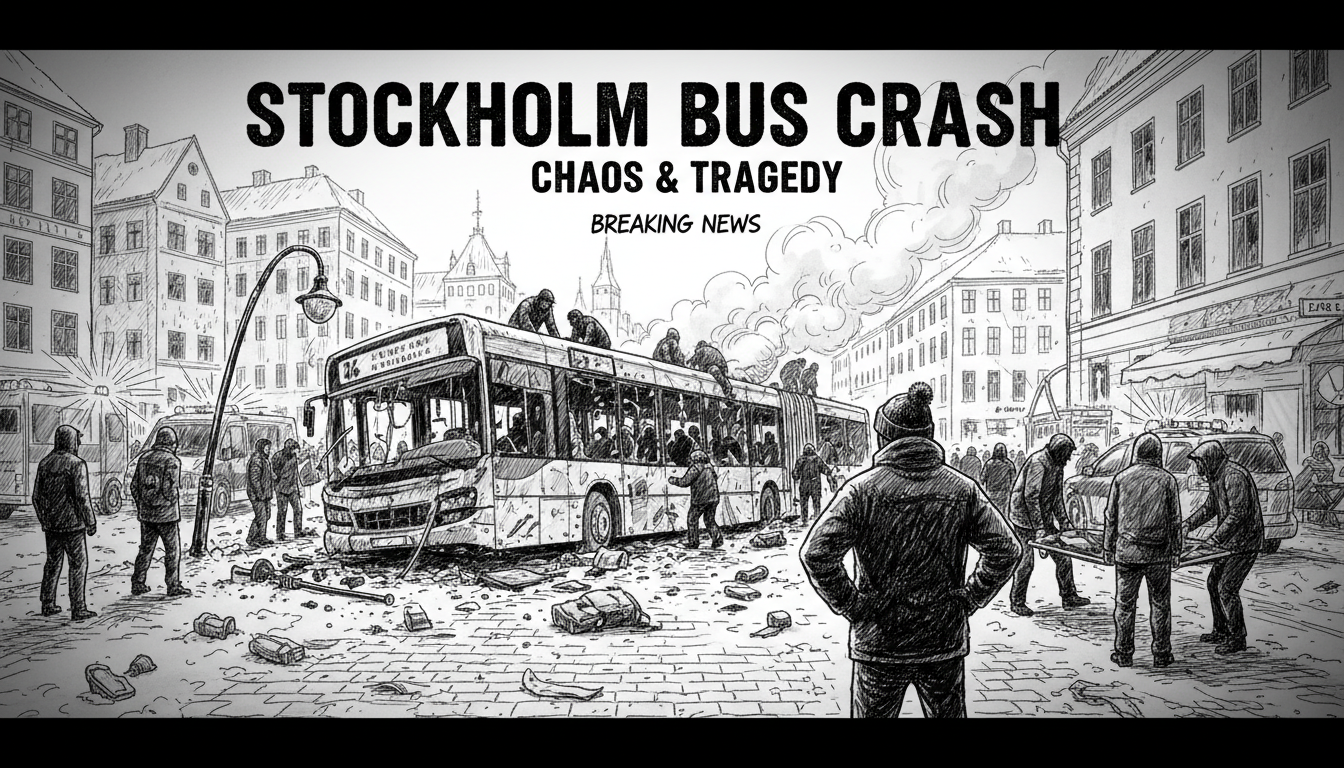A police officer with drawn weapon. A nurse breaking down after witnessing what she described as a war zone with deceased people. A teenage boy desperately trying to reach his father. The minutes following a devastating bus crash in central Stockholm were marked by pure chaos.
Sit down. SIT DOWN! The female police officer grew increasingly frustrated as she struggled to access the crashed double-decker bus. Dressed in jeans and a thin gray sweater with weapon drawn, she pulled at the front doors without success before moving to the rear entrance, equally unable to gain entry. In the background, an unmarked police car flashed blue lights while the officer shouted at the driver to open up. Nothing happened.
What began as an ordinary Friday afternoon with Stockholmers heading home for weekend relaxation transformed into tragedy. The 18-ton blue double-decker bus, which typically operates between Stockholm and Norrtälje, lost control, mounted the sidewalk, crushed an entire bus shelter to ground level, knocked down two trees, and crashed into a lamppost. The terrifying journey along Valhallavägen near Engelbrekt School covered 20-30 meters before stopping.
Michelle Mac Key, a school nurse, stepped off another bus at Östra Station just moments after the crash. I thought it was a drill at first, she recalled. The surreal quietness and limited police presence initially masked the severity. She quickly offered her medical assistance alongside two doctors who appeared simultaneously. Police, appearing somewhat confused according to Mac Key, accepted their help and directed them to two lifeless individuals behind the bus.
I cannot describe what we saw on the ground, Mac Key stated, pausing briefly. I have never seen anything like it. We just stood there, me and the doctors. There was nothing to do. It was like a war zone with deceased people. At that point, I became completely convinced this was a terrorist attack.
The scene intensified as sirens approached and police shouted through the crowd asking if anyone had witnessed anything. A crying mother stood nearby, her two young daughters having been at the location shortly before but escaping unharmed. The degree of chaos seemed to escalate minute by minute.
Seventeen-year-old Alexander Carlström witnessed the aftermath from his bus heading toward Gärdet. Suddenly I noticed people around me reacting. Someone shouted no, no, no. Another groaned Oh my God. His bus stopped at a station adjacent to the crash site, providing a clear view 10-20 meters away. He observed two lifeless bodies receiving no attention and two injured people being assisted, with considerable blood visible on the ground.
Carlström also witnessed something that disturbed him deeply. A man walked up and filmed the lifeless bodies, really close. From just a few meters away. It felt disrespectful. Michelle Mac Key observed similar behavior, calling it disgusting. Completely disgusting!
Police communications officer Ola Österling didn't hesitate when commenting on the filming incidents. He didn't rule out criminal investigations for privacy violations if individuals with mobile footage are identified. Österling praised the early-arriving female officer with drawn weapon. Completely correct. We had absolutely zero information at that point. It very well could have been a terrorist attack.
The driver, reportedly in his 60s, was eventually extracted from the vehicle and suspected of causing death and bodily injury to others. Österling defended the officer's actions. I believe she acted professionally and with good police judgment. The driver received hospital treatment and was initially arrested before being released the following day while maintaining the criminal suspicions.
This incident raises important questions about emergency response protocols in Swedish urban centers and public behavior during crises. The quick assumption of terrorism reflects contemporary security concerns, while the immediate filming of victims highlights evolving social norms around tragedy and privacy. Stockholm's transport infrastructure faces scrutiny as investigators determine whether mechanical failure, human error, or other factors caused the deadly incident. The psychological impact on witnesses and first responders underscores the need for adequate mental health support following traumatic public events.
According to Stockholm Region authorities, three people received hospital treatment, with one remaining hospitalized Saturday with serious but non-life-threatening injuries. The transport company Transdev, operating the route for SL, stated the driver was scheduled for a break when the crash occurred. The bus was not in regular service and empty of passengers at the time of incident.
The Stockholm bus crash represents one of the more serious public transport incidents in the city in recent years, occurring in a prominent residential area near schools and businesses. Swedish authorities maintain generally strong safety records for public transportation, making this event particularly shocking to residents accustomed to reliable systems. The investigation continues as officials piece together the sequence of events that turned a routine Friday into tragedy.

